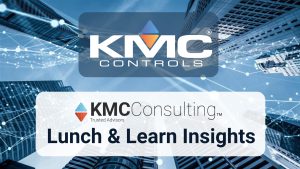

Ari Reubin, KMC Controls
In an ever-evolving technological landscape, intelligent buildings are reshaping our interaction with the spaces we inhabit. In January of 2024, select industry leaders shared their insights on smart building automation, highlighting the innovative integration of technology in commercial real estate.
The event was a Lunch & Learn webinar hosted by Ari Reubin, consulting expert at KMC Controls, alongside notable industry figures: Tim Vogel from KMC Controls (Connected Solutions) and Emmanuel Daniel, now the CEO and founder of Alosanar, formerly of Microsoft. With their combined expertise, the stage was set for a deep dive into smart buildings and their impact on both the present and future.
What Defines a Smart Building?
Tim Vogel initiated the discussion by exploring both traditional and evolving definitions of smart buildings. The “smart building” concept centers around how we connect and run the critical systems of a building. Environmental systems such as HVAC and lighting, air exchange rates, “people moving” such as with escalators or elevators, utilities and internet access are all components of a smart building. The bottom line to this is to make it possible for employees to be able to do the work they are tasked with doing and how we can run these systems as efficiently as possible.

Tim Vogel, KMC Controls
This used to be solely accomplished through using direct digital controls and centralized workstations, but today’s concept of a smart building extends beyond mere operational efficiency. Modern smart buildings utilize cloud computing and advanced analytics to enhance both safety and operation, providing capabilities like real-time problem identification and automated individualized maintenance alerts.
The Evolving Needs of Smart Buildings
Emmanuel Daniel from Microsoft enriched the conversation by addressing smart buildings from the perspective of property owners and managers. He shared that the initial focus of the smart building was on pure efficiency with systems such as lighting and HVAC. However, he said, now we are moving to a time when we heavily consider the importance occupant productivity and effectiveness. Managers and owners are now looking at their employees as individuals and considering questions like, “What is good lighting for this person?” and “How does the air quality boost this person’s cognitive abilities?”
The panel noted that there has been a shift away from simple set-and-forget programming to systems that dynamically adapt to the needs of the occupants themselves.
With workforce demographics shifting, Daniel advocated for a holistic approach to building design that begins at the conception phase and extends throughout the building’s lifecycle. “Not thinking about being green from the start is a waste,” he admonished, “Builders and designers [in the conceptualization phase of creating a building] do sunlight modeling and wind modeling but don’t do occupancy modeling and digital system modeling.”

Emmanuel Daniel, Alosanar
He postulated that we feel it’s not required until the commissioning phase. Daniel stated:
“It removes the human engagement; people-flow gets influenced as you take people on a journey through the building, helping drive people together at pivotal junctures to inspire innovation. We must provide collaborative spaces, determined through behavior modeling. This perspective ensures that buildings are not only efficient and sustainable but also meet occupant needs adaptively through detailed data integration and behavioral modeling.”
The Convergence of IT and OT
A significant theme emerged: the convergence of information technology (IT) and operational technology (OT) based infrastructural understandings (HVAC/lighting) in building systems. From intermobility and consistent policies to cyber security concerns, IT is getting more involved in OT.
As Daniel elaborated, the digital integration platform (DIP) is a revolutionary concept allowing for seamless IT and OT convergence, enabling customized user experiences. Tim Vogel highlighted how these advancements are critical, enabling the real-time interactions and decision-making essential for modern intelligent building operations.
The panel discussed how all buildings that we can walk into today must adhere to codes that keep us safe and comfortable. We want to feel connected, safe, and welcome, and building managers are taking these factors seriously. For example, Daniel shared an instance where a building owner stipulated that people want to be “recognized.” So, IT and OT can converge for digital signage saying hello and goodbye to each person as one way to address this human need. These are simple behavioral motivations backed with IT and OT technology – and it requires the coordination of multiple systems.
 Human-Centric Design and Experience
Human-Centric Design and Experience
A pivotal discussion point was the human-centric approach in smart building design. Daniel illustrated how Microsoft’s building strategies cater to occupant needs, offering personalized experiences that promote productivity and engagement. This involves adapting spaces dynamically to human activities and ensuring that each occupant’s experience within a building is seamless and intuitive, without their conscious recognition of the underlying technologies at play.
DIPs integrate all data, creating a “micro-serve” layer where we can then orchestrate services to create those custom experiences. Interpreting data about the human experience and expectation of building operations requires looking at the environment itself—we expect a different environment in a hospital than in a school or office.
 In human-centric design, we also consider how human needs change over the life cycle. A single space needs to be designed to be appropriate for a person right out of college, to someone who needs adaptable hours as they juggle family life and then as that person matures. We must take human needs into account as a top priority in designing our spaces, considering the total user experience, giving a good, hard look at why we have a smart building. Daniel rightly pointed out that “What is smart today may be a requirement in the future.”
In human-centric design, we also consider how human needs change over the life cycle. A single space needs to be designed to be appropriate for a person right out of college, to someone who needs adaptable hours as they juggle family life and then as that person matures. We must take human needs into account as a top priority in designing our spaces, considering the total user experience, giving a good, hard look at why we have a smart building. Daniel rightly pointed out that “What is smart today may be a requirement in the future.”
Smart buildings must now include cloud-connected solutions for optimizing energy efficiency at any given time, moving away from static scheduling and programming to dynamic. Rather than assessing energy at singular points in time, we must look at readings in real time for continuous interpretation of data. This allows us to adjust our settings for greater efficiency.
Closing Thoughts and Future Discussions
The webinar concluded with reflections on the continuous evolution of smart buildings. Emmanuel Daniel urged that buildings must evolve to suit the transformative work environments of today, supporting occupants around the clock, indoors and out. Vogel addressed the enduring importance of energy efficiency, again stressing innovative strategies like dynamic scheduling that utilize real-time data.
The session’s final takeaway underscored the symbiotic relationship between human needs and building capabilities—a forward-thinking approach that sets the framework for future developments in this sector. Watch the full video here: KMC Lunch N’ Learn | Intro To Smart Building Automation.
Join Us Next Week
Looking ahead, next week’s highlighted Lunch & Learn from February 2024 extends this conversation by focusing on integrated HVAC and airflow management. This webinar dove deeper into tactical engineering approaches, featuring experts Erich Kreuter and Dr. Ian Nelson. Readers can expect a comprehensive exploration that bridges strategy with practical implementation.
KMC Controls is an independent and family-owned manufacturer of turn-key solutions based in New Paris, Indiana. For the last fifty years, KMC Controls has remained dedicated to the American ideals of quality and innovation, focusing on intuitive solutions created by responsive and supportive people.
Consider us your Building Geniuses® who are building geniuses, one blog post at a time! KMC is dedicated to inspiring interest in the fields of science, technology, engineering, and mathematics. Join us for the next twelve weeks as we learn more about KMC Consulting’s Lunch and Learn Insights.
 Cart
Cart